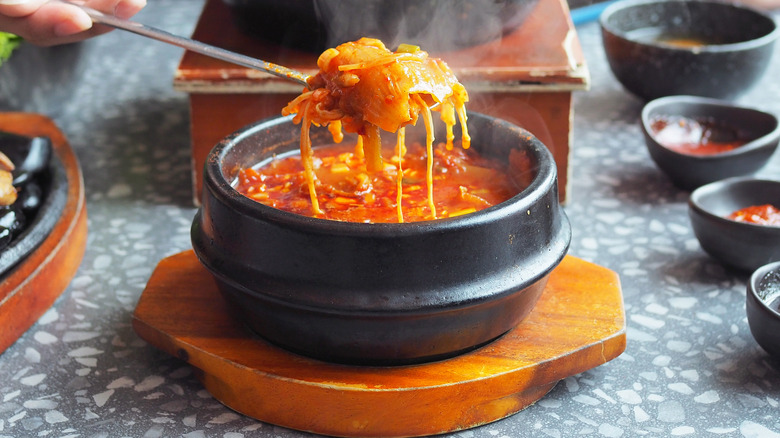David Chang's Crucial Tip For Properly Eating Korean Stew
Served boiling hot and packed with ingredients, jjigae — also known as Korean stew — is a concentrated dose of salt, spice, and umami that customarily comes with a side of rice to cushion the strong flavors. But if you're the type to mix it all together before you dig in, you might want to break the habit before your next order: As David Chang tells it, the proper way to eat jjigae is to enjoy the stew and the rice separately. In a video uploaded to his Instagram account, he insists over a still-sizzling bowl of kimchi jjigae that you should never "put rice into the jjigae," as you should be taking a spoonful on its own before chasing it down with anything else.
Now, you might be wondering why he considers it such a faux pas — as one comment mentions, there's even a Korean dish that's based on adding rice directly to the broth, called gukbap. The crucial difference here is that gukbap is made with Korean soup — called guk — which has lighter flavors. Jjigae, on the other hand, is defined by a potent and complex flavor profile; diluting it with rice before your first bite is just a waste of a good jjigae. The only way to get the most out of it is to get the full blast of flavor in one spoonful, then soak up the powerful aftertaste with a bite of rice.
Try adding rice to the leftover Korean stew
The texture of the rice is also part of why you should enjoy it separately from your mouthful of jjigae. A bowl of rice fresh out of a pressure cooker has a fluffy yet chewy mouthfeel that's perfect for chasing down the scalding hot flavors of jjigae. The distinct textures in sequence is key to the experience, and dunking the rice in the broth right away will just leave you with a soggy mess of wasted potential.
That's not to say you should never mix rice with Korean stew. Adding some day-old rice before reheating it is actually one of the most common ways of enjoying leftover jjigae. As with lasagna or chili, jjigae is often much more flavorful and potent after being left in the fridge overnight; there's so much flavor that it'll hardly taste diluted at all after mixing in some rice to make an easy, risotto-esque meal over the stove. Spicier stews made with gochujang or gochugaru, like sundubu jjigae or budae jjigae, are especially yummy when reheated the next day. Give it a try the next time you find yourself with leftover jjigae — whether by making it yourself or getting takeout — and you just might discover a new favorite comfort food to enjoy on those low-effort kind of days.

